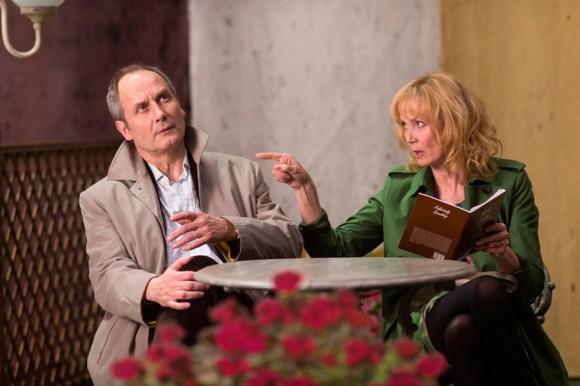The film is perhaps the strongest of his three Ayckbourn adaptations which included After Smoking/No Smoking (1993) and Coeurs (2006)
The action begins with rehearsals for a new play at an amateur dramatic society. Colin and Kathryn have received news that their friend George is fatally ill with only a few months left to live. Kathryn was once George’s girlfriend and she is devastated. But her friends Tamara and Monica are also upset. All of them are thrown back into memories of their youth and the dreams they never realized. George is to go on one final journey to Spain and all of them are invited one by one to go with him. The women begin to argue about who should accompany him.
Ayckbourn is known for his highly stylized comedies of manners and Renais seems to have a perfect match with this interest in form and style. Renais is in his 91st year but the film is full of a life and energy that many a younger film director could do with absorbing. This is a master at work and Renais’s refined style and wit have not diminished with age.
Renais brings with him many of his stock company of French actors who take to the Renais style with ease especially his wife Sabine Azema a frequent player in her huband’s films and many say his muse.
The story of the play and the film involves three suburban British middle-class couples in a typical Ayckbourn mix. There is Kathryn played by Renais’s wife, Sabine Azema and her husband Colin played by Hippolyte Girardot. Both are cast in an amateur version of what just happens to be Alan Ayckbourn’s Relatively Speaking. Also treading the boards are a second couple Jack played by Michel Viullermoz who is George’s best friend and his wife Tamara played by Caroline Silhol. The third couple is Monica George’s estranged wife played by Sandrine Kiberlain and Simeon her new boyfriend played by Andre Dussolier.
When Jack decides to drop out of the play the plot thickens as the women propose that George has just long enough left to live to take over Jack’s role.
Renais cleverly intertwines the artificiality of the play with scenes of the Yorkshire countryside. Each act of the play frames a set of events on the screen with no attempt to make them look anything other than the artificial constructions and backdrops that they are.
The story revolves around three couples. First we meet Kathryn (played by Resnais’ wife and frequent muse, Sabine Azema) and her doctor husband Colin (Hippolyte Girardot), who have both been cast in Peggy’s production, though Kathryn constantly childes her spouse for not taking his acting seriously enough. Early on, Colin reveals that their close friend, George Riley, has just been handed a terminal cancer diagnosis, news Kathryn spreads to George’s oldest friend, Jack (Michel Vuillermoz) and his wife, Tamara (Caroline Silhol), whose country manor doubles as the “Relatively Speaking” rehearsal studio. When Jack drops out of the play, the ladies propose George as his replacement, having calculated that he will live long enough to make opening night, though it soon becomes clear that both have other reasons for wanting to spend time in the dying man’s company. Rounding out the sextet of visible characters are George’s estranged wife, Monica (Sandrine Kiberlain), and the new man in her life, the retiring gentleman farmer Simeon (Andre Dussolier).
This becomes an art in itself as Resnais uses drawings created for the film by French cartoonist Blutch that dissolve and into the real life scenes of the countryside. Renais has always been a daring auteur who created art through form and artificial devices rather that just to shock. This is perhaps not the greatest work of his career which includes a number of masterpieces such as Hiroshima mon amour and Wild Grass but it is nonetheless a major and successful work to be added to the oeuvre of one of the greatest European auteurs and needs to be seen.




















